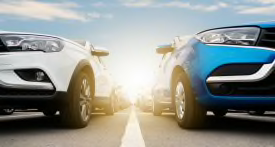The Aviator delivers an upgraded driving experience with a more sophisticated, luxurious cabin than the Ford Explorer with which it shares the same platform. We’re not thrilled with some of the Aviator’s tricky controls and the so-so fuel economy, but in most other ways it is a pleasant and well-rounded three-row luxury midsized SUV.
A 3.0-liter turbocharged V6 with 400 horsepower moves the Aviator down the road with effortless authority, and always has plenty of oomph in reserve for any situation. The 10-speed automatic transmission usually shifts quickly and smoothly, other than an occasional bumpy shift we experienced during low-speed driving. Fuel economy isn’t stellar, at 19 mpg overall, though at least it uses regular fuel instead of premium--not always a given with luxury models.
The Aviator is surprisingly agile for such a large and substantial vehicle. It holds the road well through corners, thanks to precise steering and minimal body lean. The ride is steady, and the taut suspension soaks up most bumps well. The SUV soars along the highway with an impressively tranquil and hushed cabin, but there’s some coarse engine moan during quick takeoffs that is a bit louder than expected in a luxury SUV.
We like that the Aviator’s roomy and elevated driving position gives a commanding view of the road. The front seats offer a pleasing combination of plushness and support, but the spacious second row’s bottom cushion is oddly narrow. The tight third-row seat is best reserved for transporting kids. Filled to capacity, the Aviator can accommodate seven passengers. The seats for the two rear rows can be powered up and down from the cargo area, a nice convenience when loading large or long objects.
The cabin is lavishly finished with leather, matte wood, and chrome. But the controls are quirky to the point of being perplexing. The push-button gear selector can’t be easily operated purely by feel as in many cars, the cruise-control interface is awkward and distracting to use, the voice-command button on the steering wheel-rim is too easy to activate unintentionally, and front-seat lumbar adjustments have to be made through the infotainment screen.
For 2025, Lincoln's BlueCruise "hands-free" driver assistance system comes standard. Lincoln’s Co-Pilot360 suite also comes standard and includes forward collision warning, automatic emergency braking with pedestrian detection, blind spot warning, and rear cross traffic warning.





















